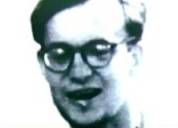 On November 18, 1961 the wooden catamaran of recently graduated American student Michael Clark Rockefeller capsized on a journey between the coastal villages of Agats and Atsj in south New Guinea due to huge waves on the Arafura Sea. Michael took the decision to swim ashore in order to fetch help. However, in Papua the swampy shore line is infested with alligators.
On November 18, 1961 the wooden catamaran of recently graduated American student Michael Clark Rockefeller capsized on a journey between the coastal villages of Agats and Atsj in south New Guinea due to huge waves on the Arafura Sea. Michael took the decision to swim ashore in order to fetch help. However, in Papua the swampy shore line is infested with alligators. 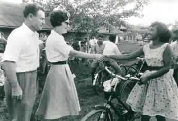 After rescuing the anthropologist and fellow traveller René Wassing, who climbed onto the up-turned hull, the Dutch Authorities set up a major search-and-rescue operation to find Michael. The Republican politician and billionaire Nelson Rockefeller, father of Michael, chartered a jet for $ 38,000 and flew to Dutch New Guinea to help in the search himself. "I’d never forgive myself," he explained, "if I did not do all that is possible to help find my son."
After rescuing the anthropologist and fellow traveller René Wassing, who climbed onto the up-turned hull, the Dutch Authorities set up a major search-and-rescue operation to find Michael. The Republican politician and billionaire Nelson Rockefeller, father of Michael, chartered a jet for $ 38,000 and flew to Dutch New Guinea to help in the search himself. "I’d never forgive myself," he explained, "if I did not do all that is possible to help find my son."
Content
1. American expedition in Baliem Area
2. Complaints about filming tribal wars
3. Collecting art for museum
4. Catamaran Capsized
5. Floating out to sea
6. Major search and rescue commences
7. Press conference Nelson Rockefeller
8. Investigating disappearance
9. Father Smit’s account
10. Links
11. Sources
1. American expedition in Baliem Area
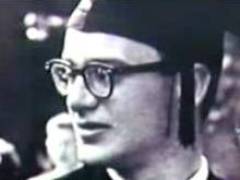 In 1960 Michel Rockefeller gained First Class Honours in English and then served in the American Army for the next 6 months. He knew full well that after his study at the Harvard Business School, he would be expected to follow a career in Business and Finance. But first Michael wanted to take part in a six month expedition among the Dani in the Baliem area in New Guinea. He was being sponsored by the Harvard Peabody Museum. His motivation to go there was driven by his need for adventure: “I want
In 1960 Michel Rockefeller gained First Class Honours in English and then served in the American Army for the next 6 months. He knew full well that after his study at the Harvard Business School, he would be expected to follow a career in Business and Finance. But first Michael wanted to take part in a six month expedition among the Dani in the Baliem area in New Guinea. He was being sponsored by the Harvard Peabody Museum. His motivation to go there was driven by his need for adventure: “I want 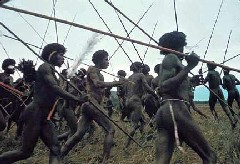 to do something romantic and adventurous in a time and place which is about to disappear”. The Harvard Expedition was to go into the wilderness of the highlands of Dutch New Guinea to film the life of cannibals on the brink of extinction. The 23-year-old Michael grew a beard and negotiated endlessly with the expedition members until he had secured a prominent position for himself. Enthusiastically, he worked as a sound technician and still photographer. During the expedition the colour film ‘Dead Birds’, an 84-minute-long documentary, was produced by the American Robert Gardner. Michael himself took 3500 photos during this expedition.
to do something romantic and adventurous in a time and place which is about to disappear”. The Harvard Expedition was to go into the wilderness of the highlands of Dutch New Guinea to film the life of cannibals on the brink of extinction. The 23-year-old Michael grew a beard and negotiated endlessly with the expedition members until he had secured a prominent position for himself. Enthusiastically, he worked as a sound technician and still photographer. During the expedition the colour film ‘Dead Birds’, an 84-minute-long documentary, was produced by the American Robert Gardner. Michael himself took 3500 photos during this expedition.
2. Complaints about filming tribal wars
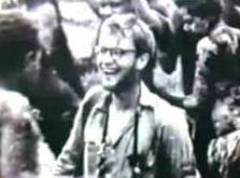 Dutch District officers complained to the government that the American scientists spurred the Dani on to start a tribal war so that they could film the event. The Hague sent a parliamentary commission to investigate this claim. In a report about the situation the commission described the actions of the expedition as being ‘unwise’ and it made the following statement in its official report to the government: ‘The Dutch Authorities are well aware of the expedition leader being extremely
Dutch District officers complained to the government that the American scientists spurred the Dani on to start a tribal war so that they could film the event. The Hague sent a parliamentary commission to investigate this claim. In a report about the situation the commission described the actions of the expedition as being ‘unwise’ and it made the following statement in its official report to the government: ‘The Dutch Authorities are well aware of the expedition leader being extremely 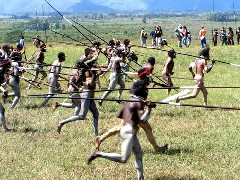 keen on filming tribal warfare. In the first two months of the expedition there were at least seven deaths and a dozen or more were wounded in the area around of Kurulu the village’. The expedition ended in September 1961 and a sun-tanned Michael paid a quick visit home. There he discovered a well-kept secret: After 31 years of marriage, his parents filed for a divorce.
keen on filming tribal warfare. In the first two months of the expedition there were at least seven deaths and a dozen or more were wounded in the area around of Kurulu the village’. The expedition ended in September 1961 and a sun-tanned Michael paid a quick visit home. There he discovered a well-kept secret: After 31 years of marriage, his parents filed for a divorce.
3. Collecting art for museum
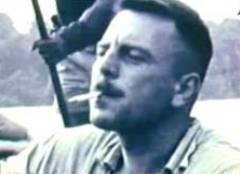 Shortly after, Michael returned to New Guinea for a three month expedition along the south coast. He intended to collect shields, painted and preserved human heads, and bisj-poles (ancestor sculptures) 20 foot high for the Museum of Primitive Art in Manhattan, New York. This museum was set up by his father Nelson. District officer and anthropologist René Wassing (34) who was working in New Guinea was added to the expedition by the Dutch authorities because he was familiar with local languages. Michael took enormous quantities of objects along so he could barter: tobacco, clothing, knives and machetes of high
Shortly after, Michael returned to New Guinea for a three month expedition along the south coast. He intended to collect shields, painted and preserved human heads, and bisj-poles (ancestor sculptures) 20 foot high for the Museum of Primitive Art in Manhattan, New York. This museum was set up by his father Nelson. District officer and anthropologist René Wassing (34) who was working in New Guinea was added to the expedition by the Dutch authorities because he was familiar with local languages. Michael took enormous quantities of objects along so he could barter: tobacco, clothing, knives and machetes of high  quality. In 1961,money was of no value in the Asmat region. Michael’s efforts were not popular among Dutch officials. One of them reported: ‘Rockefeller’s presence is leading to a huge increase in local trade, especially the demand for beautifully painted preserved heads has gone up. As few weeks ago, one of the District Officers was approached to give permission for a night of headhunting. “Please Sir, just one night!”. Michael is said to offer ten machetes per preserved head. We have had to refuse this request as it creates a demand which cannot be met without bloodshed’.
quality. In 1961,money was of no value in the Asmat region. Michael’s efforts were not popular among Dutch officials. One of them reported: ‘Rockefeller’s presence is leading to a huge increase in local trade, especially the demand for beautifully painted preserved heads has gone up. As few weeks ago, one of the District Officers was approached to give permission for a night of headhunting. “Please Sir, just one night!”. Michael is said to offer ten machetes per preserved head. We have had to refuse this request as it creates a demand which cannot be met without bloodshed’.
4. Catamaran capsized
Rockefeller and Wassing travelled along the south coast from one village to the next. The men traded shells and hatchets and collected more than 50 indigenous pieces 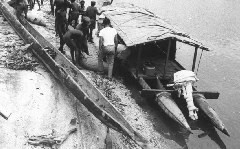 of art. In some of the villages, they were guests at the mission station where Michael showed his catamaran to the resident priests. It was made of two native canoes attached with planks and powered by an 18-HP outboard motor. Again and again the missionaries warn him that his 40 foot catamaran was unsafe as the changing tide in the Flamingo Bay could cause 20 meter high waves further along the coast. They informed Michael that at this location water from one of the local rivers collides with the turbulent waters of the Afura sea. Even 75 miles upstream, the locals cannot row against the current that is created by the
of art. In some of the villages, they were guests at the mission station where Michael showed his catamaran to the resident priests. It was made of two native canoes attached with planks and powered by an 18-HP outboard motor. Again and again the missionaries warn him that his 40 foot catamaran was unsafe as the changing tide in the Flamingo Bay could cause 20 meter high waves further along the coast. They informed Michael that at this location water from one of the local rivers collides with the turbulent waters of the Afura sea. Even 75 miles upstream, the locals cannot row against the current that is created by the 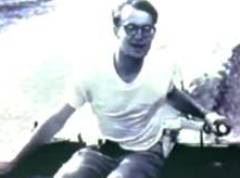 tidal fluctuation. But the advice fell on deaf ears. On the final day of their journey together, Michael, René and their two Papua guides from Agats, left for the village of Atsj, 25 miles upstream from the coast. As was later recounted by René, the catamaran was flooded instantly in the rolling seas. The water poured in at such a rate that hosing was useless and the outboard motor was totally flooded. Their gear,floating around the catamaran at this point, was hoisted into the hollow bottoms of the two canoes. The two Papua guides, who realised that it was a lost course, swam to shore to get help. Michael and René stayed behind on the upturned hull and floated off with nightfall fast approaching.
tidal fluctuation. But the advice fell on deaf ears. On the final day of their journey together, Michael, René and their two Papua guides from Agats, left for the village of Atsj, 25 miles upstream from the coast. As was later recounted by René, the catamaran was flooded instantly in the rolling seas. The water poured in at such a rate that hosing was useless and the outboard motor was totally flooded. Their gear,floating around the catamaran at this point, was hoisted into the hollow bottoms of the two canoes. The two Papua guides, who realised that it was a lost course, swam to shore to get help. Michael and René stayed behind on the upturned hull and floated off with nightfall fast approaching.
5. Floating out to sea
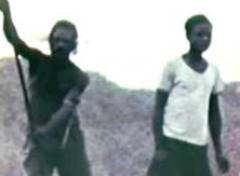 The two men saw the coast disappear into the distance; they were floating out to sea. Both were excellent swimmers but René refused to leave the boat to swimback to shore. Michael did want to leave because after being a-float for a day and a night, he assumed that the two guides had not managed to reach land. Furthermore, being restless by nature, he simply hated floating around aimlessly for hours on end. The coastline was now about 5 miles out and barely visible. Michael took off his trousers, tied his glasses around his neck and attached a bright red jerry-can onto a buoy. He roped the improvised float around his middle and the men said their goodbyes to one another. Just before leaving, Michael
The two men saw the coast disappear into the distance; they were floating out to sea. Both were excellent swimmers but René refused to leave the boat to swimback to shore. Michael did want to leave because after being a-float for a day and a night, he assumed that the two guides had not managed to reach land. Furthermore, being restless by nature, he simply hated floating around aimlessly for hours on end. The coastline was now about 5 miles out and barely visible. Michael took off his trousers, tied his glasses around his neck and attached a bright red jerry-can onto a buoy. He roped the improvised float around his middle and the men said their goodbyes to one another. Just before leaving, Michael  said: "I think I can make it." Rene argued that the tide was against him, but Michael simply dived into the water. René followed him with his eyes, a dot slowly disappearing from view. Rene, sitting on the rounded bottom of the upturned canoe, waited and waited. In the course of the day, a small plane flew overhead. Torches and a small dinghy were dumped into the sea. Rene swam to it frantically, afraid of sharks. He climbed into the boat and floated around for hours once more. The next day the plane returned. More torches were dropped off to mark his location. Finally, Wassing was hauled out off the water by a government vessel from Merauke. By this time, he was 22 miles out from the coast.
said: "I think I can make it." Rene argued that the tide was against him, but Michael simply dived into the water. René followed him with his eyes, a dot slowly disappearing from view. Rene, sitting on the rounded bottom of the upturned canoe, waited and waited. In the course of the day, a small plane flew overhead. Torches and a small dinghy were dumped into the sea. Rene swam to it frantically, afraid of sharks. He climbed into the boat and floated around for hours once more. The next day the plane returned. More torches were dropped off to mark his location. Finally, Wassing was hauled out off the water by a government vessel from Merauke. By this time, he was 22 miles out from the coast.
6. Major search and rescue operation
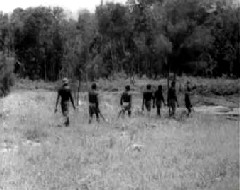 On behalf of the Dutch Authorities, Governor Pieter Platteel povided boats, planes, marines and police units in order to find Michael. Five thousand local residents combed through the swamps and mangrove trees along the coast in search of Michael. Australian and Dutch helicopters scanned the coastline. The U.S. Seventh Fleet offered aircrafts and a cargo ship, after a telegram from President John F. Kennedy,
On behalf of the Dutch Authorities, Governor Pieter Platteel povided boats, planes, marines and police units in order to find Michael. Five thousand local residents combed through the swamps and mangrove trees along the coast in search of Michael. Australian and Dutch helicopters scanned the coastline. The U.S. Seventh Fleet offered aircrafts and a cargo ship, after a telegram from President John F. Kennedy, 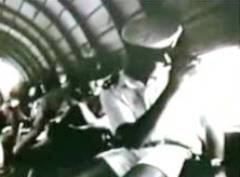 expressing his concern and offering as much help as possible. Even before Wassing had returned to Merauke, the much alarmed father, Governor Nelson Rockefeller of New York, and Michael’s twin sister Mary were already there. Rockefeller and his daughter, as well as a group of journalists, flew 10.000 miles to reach Biak and then travelled directly to Merauke in order to assist with the search and rescue operations for Michael.
expressing his concern and offering as much help as possible. Even before Wassing had returned to Merauke, the much alarmed father, Governor Nelson Rockefeller of New York, and Michael’s twin sister Mary were already there. Rockefeller and his daughter, as well as a group of journalists, flew 10.000 miles to reach Biak and then travelled directly to Merauke in order to assist with the search and rescue operations for Michael.
7. Press conference by Nelson Rockefeller
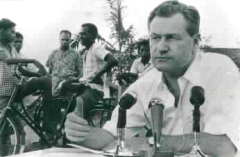 search and rescue people. They followed the progress made by the search parties from the white house, the District Commissioner’s place in Merauke. However, there was not a trace of Michael to be found. After a week, when the governor was about to return to the US, a floating jerry can was spotted 120 miles out from the coast. Even though there is but a little hope, he decides to delay his departure. Locating the red jerry can out
search and rescue people. They followed the progress made by the search parties from the white house, the District Commissioner’s place in Merauke. However, there was not a trace of Michael to be found. After a week, when the governor was about to return to the US, a floating jerry can was spotted 120 miles out from the coast. Even though there is but a little hope, he decides to delay his departure. Locating the red jerry can out  from the coastal village of Otsnajep, did not lead to finding Michael. After ten days Rockefeller discontinued the search for his son. The family could do no more. As head hunting and cannibalism still operated in some parts of the Asmat region, there was speculation that Michael Rockefeller had been murdered and eaten by some local tribe. However, Michael could have drowned and or could have been eaten by a a crocodile. This is what the authorities preferred you to believe.
from the coastal village of Otsnajep, did not lead to finding Michael. After ten days Rockefeller discontinued the search for his son. The family could do no more. As head hunting and cannibalism still operated in some parts of the Asmat region, there was speculation that Michael Rockefeller had been murdered and eaten by some local tribe. However, Michael could have drowned and or could have been eaten by a a crocodile. This is what the authorities preferred you to believe.
8. Investigating the disappearance
Eight years after the fact, Journalist Milt Machlin travelled to New Guinea to investigate Rockefeller’s disappearance. He concluded that Michael was murdered to 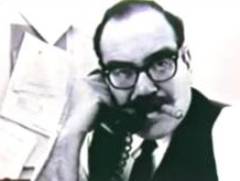 avenge the death of several leaders from the coastal village Otsjanep who had been killed by a Dutch Patrol group in 1958. The question is: Were the head hunters of Otsnajep still up in arms against the Dutch Authority or whites in general three years after this particular event? It is true that the red jerry can was located near Otsnajep. Doctor Ary Kemper, who lived in New Guinea for more than 11 years, gave his point of view on the matter.
avenge the death of several leaders from the coastal village Otsjanep who had been killed by a Dutch Patrol group in 1958. The question is: Were the head hunters of Otsnajep still up in arms against the Dutch Authority or whites in general three years after this particular event? It is true that the red jerry can was located near Otsnajep. Doctor Ary Kemper, who lived in New Guinea for more than 11 years, gave his point of view on the matter.
“ I think, he was murdered by Asmat people. It may have been for his head. He may well have been eaten. A man alone, without arms, roaming around the coast, that’s risky. But 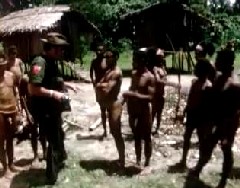 do you know why the government officials say that he perished at sea? Because they don’t want the world to think that the Netherlands do not have proper control over their colony. Officially, there is no head hunting, no cannibalism, or tribal warfare! The murder of the son of a well known millionaire would not look good in the United Nations, would it now? But six machetes, that’s a fortune! For that price, the Asmats can buy two wives. You know, for an Asmat warrior, a head is a head. They probably didn’t even realise that this particular white guy, who was half-naked, was the supplier of those machetes in the first place”.
do you know why the government officials say that he perished at sea? Because they don’t want the world to think that the Netherlands do not have proper control over their colony. Officially, there is no head hunting, no cannibalism, or tribal warfare! The murder of the son of a well known millionaire would not look good in the United Nations, would it now? But six machetes, that’s a fortune! For that price, the Asmats can buy two wives. You know, for an Asmat warrior, a head is a head. They probably didn’t even realise that this particular white guy, who was half-naked, was the supplier of those machetes in the first place”.
9. Father Smit’s account
 The Dutch priest Jan Smit, who became a missionary in New Guinea after his ordination in 1959, and who actually knew Michael, claimed that he saw a warrior walk around in Michael’s boxers. According to Smit, who was later shot dead by an Indonesian officer, the murder was committed by Papuan warriors from Otsjanep. He had heard stories that one of the warriors shot the American with an arrow while he was still in the water. Based on what he had heard of these stories, Father Smit gave the following account of the murder.
The Dutch priest Jan Smit, who became a missionary in New Guinea after his ordination in 1959, and who actually knew Michael, claimed that he saw a warrior walk around in Michael’s boxers. According to Smit, who was later shot dead by an Indonesian officer, the murder was committed by Papuan warriors from Otsjanep. He had heard stories that one of the warriors shot the American with an arrow while he was still in the water. Based on what he had heard of these stories, Father Smit gave the following account of the murder.
”Other warriors dragged the wounded American out of the water, after which they finished him off. They scalped him alive, cooked and ate some other body parts and then burried the remainder. This scenario is mainly based on statements made by the leader of the Otsjanep warriors, known as Ajik of Ajim. Some time after the search for 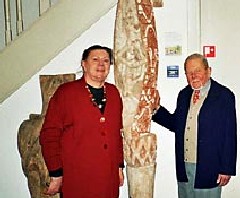 Rockerfeller, Ajik started spreading the story that he had killed ‘an important witch doctor’, a white men, that he headhunted him and that he had taken on his magical powers. At the same time, two other warriors told a similar tale. They also claimed to be responsible for his murder, as a result of which they now owned Rockefeller’s ‘magic’. As proof of this, Fin one of the two warriors, showed Rockefeller’s glasses to his audience”. However, what actually did happen remains a mystery which will probably never be solved. On his return to the Netherlands, René Wassing became the curator of the Museum voor Volkenkunde (Etnnographic Museum) in Rotterdam, now known as the Wereld (World)Museum. Wassing managed the collection and continued to buy interesting artefacts on his trips abroad. Born in Palembang on Sumatra, the now elderly Wassing still considers himself to be a child of the tropics.
Rockerfeller, Ajik started spreading the story that he had killed ‘an important witch doctor’, a white men, that he headhunted him and that he had taken on his magical powers. At the same time, two other warriors told a similar tale. They also claimed to be responsible for his murder, as a result of which they now owned Rockefeller’s ‘magic’. As proof of this, Fin one of the two warriors, showed Rockefeller’s glasses to his audience”. However, what actually did happen remains a mystery which will probably never be solved. On his return to the Netherlands, René Wassing became the curator of the Museum voor Volkenkunde (Etnnographic Museum) in Rotterdam, now known as the Wereld (World)Museum. Wassing managed the collection and continued to buy interesting artefacts on his trips abroad. Born in Palembang on Sumatra, the now elderly Wassing still considers himself to be a child of the tropics.
10. Links:
- Also refer to Theme Page: Head Hunting on the South Coast and Eyewitness Account of Head Hunting
- Wikipedia article on Michael Rockefeller
- Jos van den Berg’s website with his description on meeting Rene Wassing in October 2005.
- Outside magazine: "Lost Scion: Was Michael Rockefeller eaten by cannibals?"
- Asmat Art in Michael C. Rockefeller Collection of the Metropolitan Museum of Art
- Article ‘Who Was Michael C. Rockfeller’ by Fredonia.edu
- Twelve of 3500 photos made by Michael Rockefeller in the Baliem Area (May-July 1961)
11. Sources:
- John Godwin’s book ‘The Search for Michael Rockefeller’ , citing René Wassing
- Documentary ‘The Search for Michael Rockefeller’ by Milt Machlin (Agamemnon Films). In this Father Cornelius van Kessel talks about what happened.
- Video In Search Of... Michael Rockefeller, in three parts You Tube: part 1, part 2 and part 3
- Paul Toohey, Rocky goes West. Sydney, Duffy and Snellgrove, 1977. ISBN: 1875989196.
- Advice and comments: Sjoerd Jaarsma and Nancy Jouwe